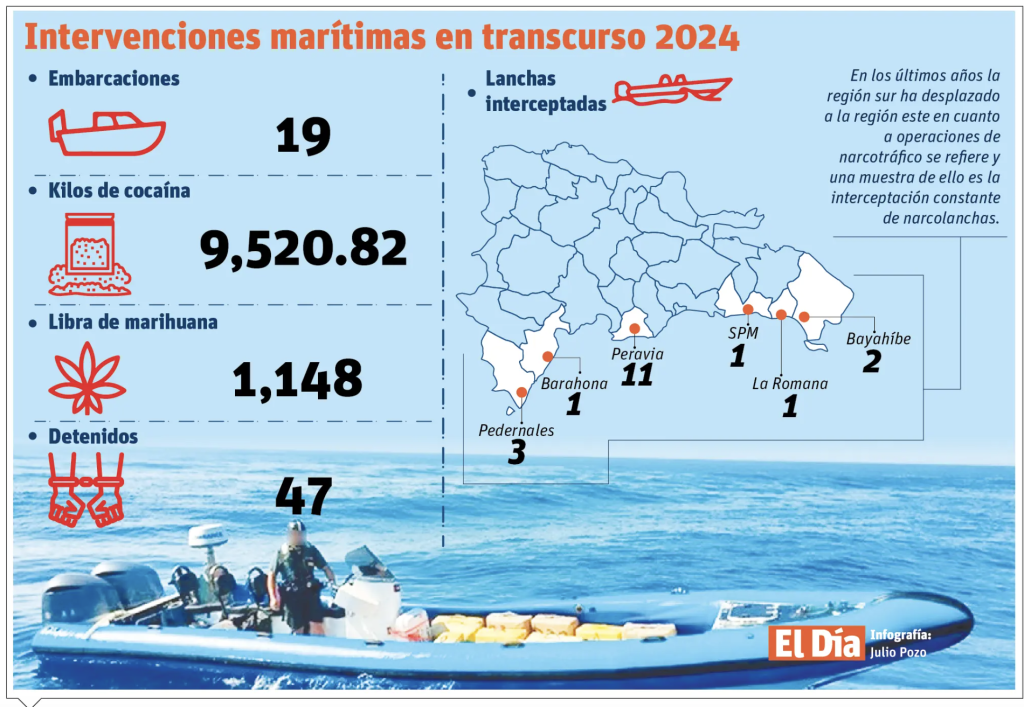
The geographical location that is a blessing for trade is a curse and the Dominican Republic continues under the siege of drug traffickers that seek to use the country as a transshipment point to the United States and Europe.
Intercepting drug shipments from South America that are smuggled into the Dominican Republic via sea is costly and requires meticulous coordination of intelligence and logistics. El Dia publishes today a report that explains details of all the hard work that is behind the increased successes of the National Drug Control Agency (DNCD) during the Abinader administration, when compared to past governments. The DNCD reports seizing more than 142 tons in the present government, compared to around 2 tons in the previous government.
Carlos Devers, spokesperson for the National Drug Control Agency (DNCD), told El Dia that these operations begin with intelligence, evolve into a tracking process, and conclude with the presentation of the seized cargo. They involve agents from the DNCD, Armed Forces, National Police, and representatives of the Public Ministry, and can last more than 72 hours.
Once the anti-narcotics agency receives an international alert about the movement of a suspicious vessel, a protocol is activated. Upon entering Dominican territorial waters, tracking begins, depending on whether the alert originates from the south or east of the island.
As the drug-laden boat enters Dominican jurisdictional waters, maritime, aerial, and ground teams are coordinated, supported by radio frequency and geolocation equipment. A group of analysts also monitors the situation from the DNCD’s Command and Control Center.
In most cases, a Super Tucano aircraft from the Dominican Republic Air Force (FARD) flies over the area and then passes the coordinates to a helicopter that will provide support to fast boats and a Dominican Republic Navy (ARD) ship to intercept the drug traffickers.
In addition to the aforementioned air units, the ARD has three to four fast boats that can carry six or seven people and up to 450 gallons of fuel for pursuit and tracking.
While search and rescue teams venture into the sea to intercept the drug boats, ground and maritime units remain on land and at the port awaiting updates.
The DNCD spokesperson notes that intelligence indicating a possible drug trafficking operation can be received days in advance, requiring more personnel for coastal surveillance, longer working hours, equipment, and logistics.
Just as the authorities deploy all the operations described above, drug traffickers use maneuvers and tricks to try to succeed in their operations, which can take more than 24 hours from South America.
For example, drug traffickers divide their cargo into three or even four trips. On other occasions, they seek to reduce shipping costs by taking the entire cargo to the high seas and then, from there, three or four boats, simulating being fishermen, distribute the load by accessing different points of the country’s coastal zone in an operation known as “medio palo” (half a stick).
Drug traffickers also use simple tools such as blue tarps to camouflage themselves at sea and thus try to evade aerial tracking. They also receive information on land from associates via satellite phones and GPS.
As reported in El Dia, boatmen receive between US$22,000 and US$25,000 for the journey, the price of which varies depending on the volume of the cargo.
The DNCD spokesman explained that when DNCD and ARD maritime units spot the drug boats, the pursuit begins, which, in many cases, involves shootouts and the dumping of the cargo into the sea. This subsequently requires the involvement of more personnel and boats to recover the narcotic load before “fishermen” in the service of drug trafficking rescue it.
The risky operation requires personnel trained in rescue and first aid in case of any incident.
Such was the case in the operation carried out on 31 July 2024, which resulted in the seizure of 532 packages of cocaine and 11 packages of marijuana off the coast of the province of Peravia. The four occupants of the boat, three Dominicans and one Colombian, had to be rescued in the Caribbean Sea after the boat they were using to introduce the cargo capsized during the pursuit.
After neutralizing the boat and arresting the individuals, the authorities proceed to tow the drug boat to the nearest port in a custody operation with the support of air units.
Once at the port, the Public Ministry begins the protocol of counting the narcotic cargo in the presence of the detainees, and it is placed and sealed in evidence bags. Reports are then drawn up for the convoy’s transfer to DNCD headquarters.
Subsequently, the cargo is placed in a vault at the anti-narcotics agency until it is presented to the media at a press conference and finally sent in a chain of custody to the National Institute of Forensic Sciences (INACIF), where it is analyzed to determine its exact type and weight.
So far this year, authorities have seized approximately 10 tons of cocaine and more than 1,000 pounds of marijuana in maritime operations alone. The months of March and July 2024 have recorded the highest number of interceptions of boats that have attempted to introduce shipments into Dominican territory, with four each.
The National Drug Control Agencty emphasizes that international cooperation, based on trust in local authorities, has been key to the success of anti-narcotics operations in recent years. 90% of the cocaine-laden boats intercepted this year have originated from Colombia. The United States has provided drones to support surveillance in the Caribbean against drug trafficking, in addition to agents who assist at the country’s ports to profile suspicious cargo.
Read more in Spanish:
El Dia
DNCD
DNCD
13 August 2024

